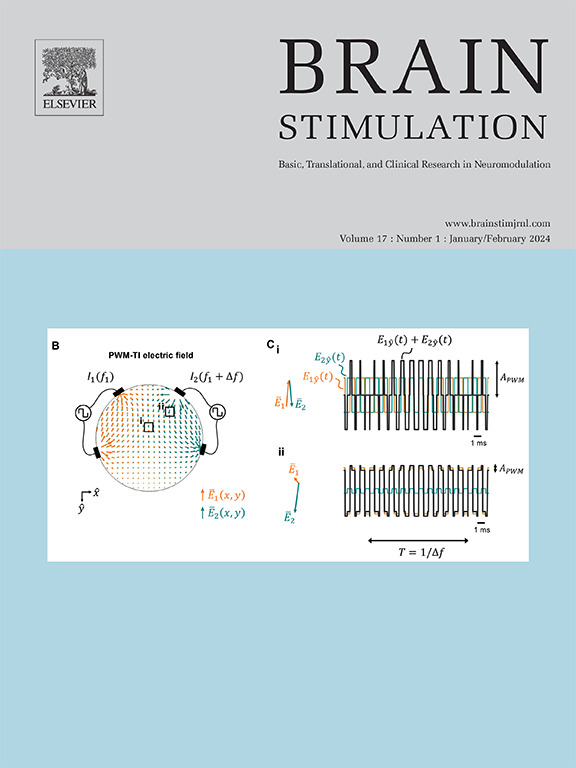Vagus nerve stimulation in treatment-resistant depression: A one-year, randomized, sham-controlled trial
IF 8.4
1区 医学
Q1 CLINICAL NEUROLOGY
引用次数: 0
Abstract
Background
Few treatments are available for individuals with marked treatment-resistant depression (TRD).
Objective
Evaluate the safety and effectiveness of FDA-approved adjunctive vagus nerve stimulation (VNS) in patients with marked TRD.
Methods
This 12-month, multicenter, double-blind, sham-controlled trial included 493 adults with marked treatment-resistant major depression who were randomized to active or no-stimulation sham VNS for 12 months. The primary outcome was percent time in response across months 3–12, with response defined as a ≥50 % change from baseline on the Montgomery-Åsberg Depression Rating Scale (MADRS). Several secondary endpoints were evaluated.
Results
Overall, 88.4 % of participants completed the trial. Percent time in MADRS response did not distinguish active from sham VNS. However, ratings from on-site clinicians (Clinical Global Inventory–Impression [CGI-I]), patients (Quick Inventory of Depressive Symptomology–Self Report [QIDS-SR]), and offsite masked raters (Quick Inventory of Depressive Symptomology–Clinician [QIDS-C]) revealed antidepressant benefits significantly favoring active VNS. Active VNS demonstrated significantly more percent time in response on the CGI-I (P = 0.004) and QIDS-SR (P = 0.049), and significantly more percent time in partial response (PR; symptom improvement ≥30 %) on the CGI-I (P < 0.001) and QIDS-C (P = 0.006) versus sham VNS. Active VNS exceeded sham VNS in rate of dyspnea (P = 0.035), a known side effect of VNS. No new adverse events were identified.
Conclusions
Percent time in MADRS response did not distinguish the treatment groups, but on multiple instruments time in response and PR showed a positive treatment effect. VNS was found safe and effective in participants with marked TRD.
迷走神经刺激治疗难治性抑郁症:一项为期一年的随机、假对照试验。
背景:很少有治疗方法可用于治疗难治性抑郁症(TRD)。目的:评价经fda批准的辅助迷走神经刺激(VNS)治疗明显TRD患者的安全性和有效性。方法:这项为期12个月的多中心、双盲、假对照试验包括493名患有明显治疗难治性重度抑郁症的成年人,他们被随机分为主动或无刺激的假VNS组,为期12个月。主要终点是3-12个月间的缓解时间百分比,根据Montgomery-Åsberg抑郁评定量表(MADRS),缓解定义为与基线相比变化≥50%。评估了几个次要终点。结果:总体而言,88.4%的参与者完成了试验。MADRS反应的百分比时间不能区分活跃和假VNS。然而,现场临床医生(临床总体量表-印象量表[CGI-I])、患者(抑郁症状快速量表-自我报告[QIDS-SR])和非现场掩饰评分者(抑郁症状快速量表-临床医生[QIDS-C])的评分显示,抗抑郁药物的效果明显有利于主动VNS。主动VNS在CGI-I (P = 0.004)和QIDS-SR (P = 0.049)上的反应时间显著增加,在部分反应(PR;结论:MADRS反应时间百分比对治疗组无明显差异,但在多仪器反应时间和PR上均显示积极的治疗效果。VNS对TRD明显的参与者是安全有效的。
本文章由计算机程序翻译,如有差异,请以英文原文为准。
求助全文
约1分钟内获得全文
求助全文
来源期刊

Brain Stimulation
医学-临床神经学
CiteScore
13.10
自引率
9.10%
发文量
256
审稿时长
72 days
期刊介绍:
Brain Stimulation publishes on the entire field of brain stimulation, including noninvasive and invasive techniques and technologies that alter brain function through the use of electrical, magnetic, radiowave, or focally targeted pharmacologic stimulation.
Brain Stimulation aims to be the premier journal for publication of original research in the field of neuromodulation. The journal includes: a) Original articles; b) Short Communications; c) Invited and original reviews; d) Technology and methodological perspectives (reviews of new devices, description of new methods, etc.); and e) Letters to the Editor. Special issues of the journal will be considered based on scientific merit.
 求助内容:
求助内容: 应助结果提醒方式:
应助结果提醒方式:


